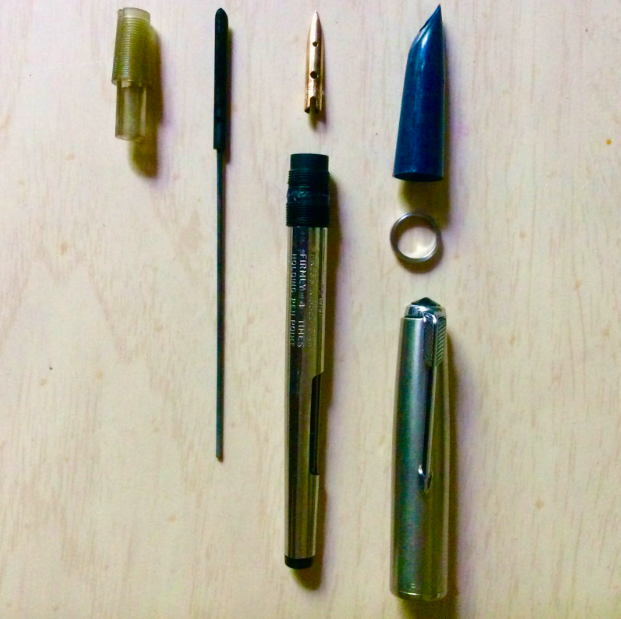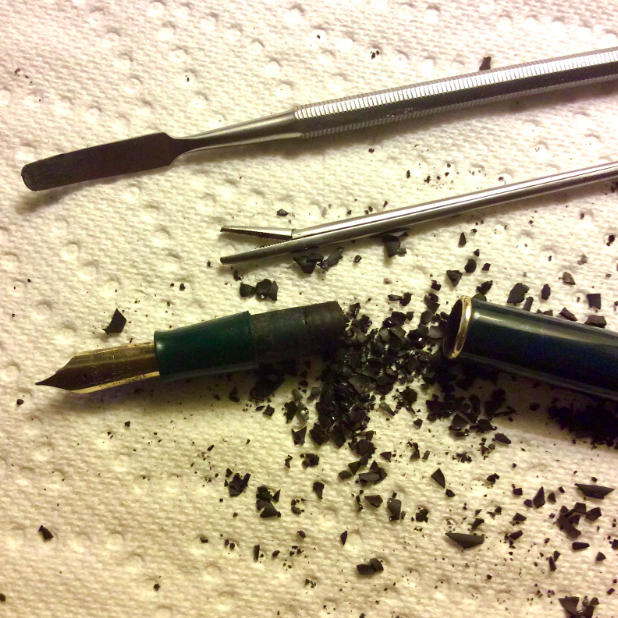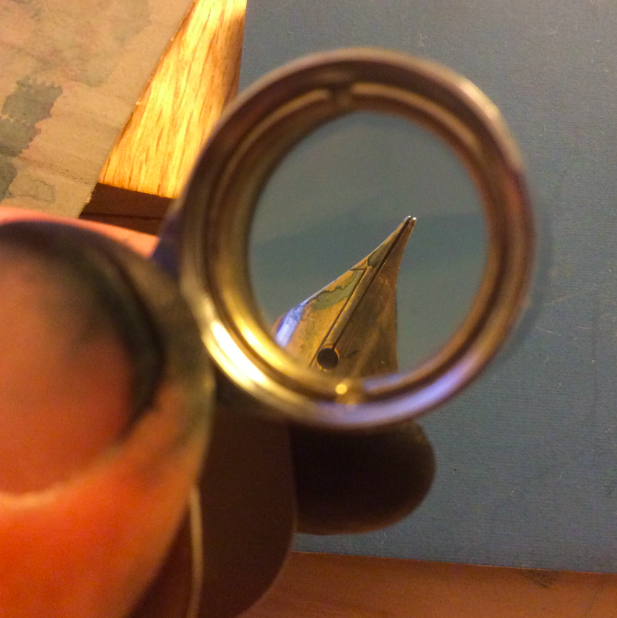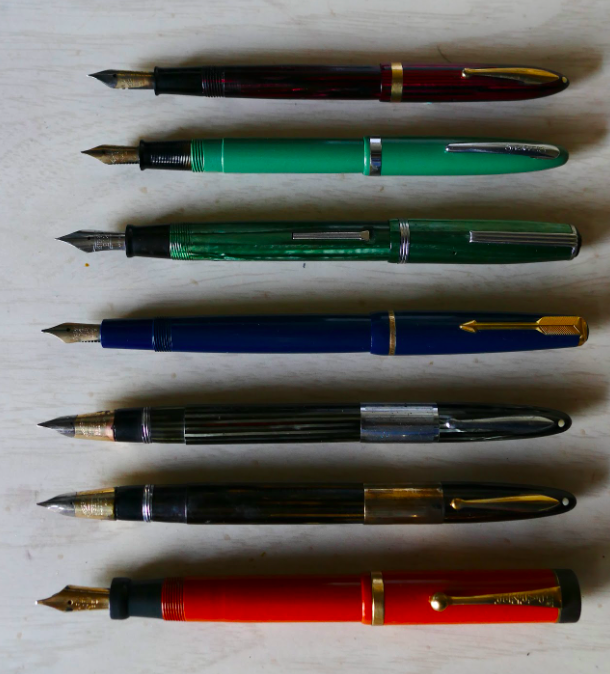Welcome to When I’m Not Writing, a new series in which we invite writers to tell us about the things they do when they’re not, you know, writing. Writers are not, as idyllically pictured, always tucked away in their garret, typing. They are out in the world, skinning their knees and putting their hands in the soil. And don’t you want to know about it? From lifelong passions to newfound pandemic hobbies to creative productive procrastination methods, the obsessions gathered here run the gamut, but they all pull back the curtain a bit and let us be a fly on the wall of extraordinary daily living.
*
My first year in high school, my father gave me my grandfather’s pen. I had mostly been writing with mechanical pencils, but here was this sleek, gold-filled Parker 180 made even more elegant by its barley pattern etching. The filling mechanism no longer worked, but after an hour of tinkering, my father was able to revive it with a delicate operation involving glue and electrical tape. Unlike with other kinds of pens, I couldn’t write with it right away. I first needed to dip it in a bottle of ink so it could fill up. Then all I had to do was glide its gold nib across the page, no pushing into the sheet. I moved my hand in widening circles. Even after decades of disuse, the pen began to pour out ink.
During a university-era trip to New York City, I bought my own fountain pen at the Pearl Paint on Canal Street. The yellow, plastic-bodied Lamy Safari wasn’t quite as refined as my grandfather’s Parker, but it gave me more peace of mind to carry around than a more sentimental pen. The pen worked well for taking notes as long as I could read what I’d written.
I’m a messy writer. My letters are loopy, sometimes ending with forceful flourishes propelled by excitement of thought. Fountain pens are arguably the only kind of pens that can keep up with my way of writing.
Restoring vintage pens offered respite from that abstraction, with the reward of a writing instrument I’d be able to use. I could cheaply buy pens neglected in someone’s drawer for decades and give them new life.
I began to collect more of them after the makeshift fixes on my grandfather’s pen inevitably fell apart. I went on fountain pen internet message boards for guidance (replace the pen’s original converter, they said; easy enough) and soon found myself bidding on disused pens at online auctions. I started repairing Esterbrook model J pens from the 1940s with their simple lever-filler mechanisms. Pull a lever at the side of the pen and then let a springbar snap back so ink could fill the vacuum inside a rubber sac. With long, narrow surgical forceps, I pulled out the corroded parts and installed new ones. The whole process took minutes, after which I had a restored pen that wrote better than more expensive modern versions.
I found the pen restorations relaxing. I often stared at screens, tapping and clicking on cold interfaces. I was writing but where? My words pixelated on cold, electric blankness. They appeared to me like silent ghosts yet born into the world. Restoring vintage pens offered respite from that abstraction, with the reward of a writing instrument I’d be able to use. I could cheaply buy pens neglected in someone’s drawer for decades and give them new life.
I took on more difficult projects: 1940s Parker Vacumatics in need of specially threaded tools and tiny drill bits to rework, piston fillers with seals that had to be replaced, and 1930s Sheaffer Vac-Fils with tricky nib removal and even trickier use of plumbers’ solvents. Once, I was even able to weld back together pieces of a late 1970s Montblanc—overpriced in its newer incarnations—that I’d dropped and shattered on a Brooklyn sidewalk. It still writes well.
As I write, I’ve come to know the different personalities of my pens. Oftentimes, the tipping of my pens’ nibs had been shaped by the individual writing angles of their previous owners.
I often worked on open restoration projects after I’d finished a draft of a novel section or between stories. The repair sessions offered time out of time. I could look down at broken, gunked up mechanisms inside celluloid barrels and look up again after hours that seemed like minutes. When I returned to my writing, I was a little stranger to it than before.
As I write, I’ve come to know the different personalities of my pens. Oftentimes, the tipping of my pens’ nibs had been shaped by the individual writing angles of their previous owners, whose names were sometimes engraved on the barrel—hello, Geraldine, hello, E.F. I had to adjust the way I held each; perhaps someday, were I to write enough with it, the tipping will angle closer to how I write. A few I had tuned and customized by nibmeisters at pen shows. Certain nibs, especially older ones, are more flexible, allowing for wider, calligraphic lines. Some are scratchy but in a good way. Some write extremely fine lines—great for marking edits—and others gush rivers of ink when I want to feel expressive.
Writing with these fountain pens may or may not make any clear difference for my writing, but before my words turn into digital pixelation on a laptop screen, the pens help my work feel a little more like play. I like to describe that early phase of writing as sculptural. The energetic motions of my hand shape a story that for a while exists in the same physical plane as its writer. I make words appear on paper I can hold, and they speak back.
 A disassembled and cleaned 1950s Parker 51 with an Aeromatic filler.
A disassembled and cleaned 1950s Parker 51 with an Aeromatic filler.
 A 1950s Waterman Corinth lever filler having dessicated rubber scraped from inside its barrel.
A 1950s Waterman Corinth lever filler having dessicated rubber scraped from inside its barrel.
 The bent nib of a 1940s Parker Vacumatic being carefully reworked.
The bent nib of a 1940s Parker Vacumatic being carefully reworked.
 A selection of 1930-60s fountain pens restored by the author.
A selection of 1930-60s fountain pens restored by the author.



